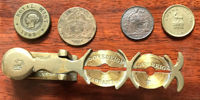What Is a Sovereign? All About the British Sovereign Gold Coin
Posted on June 23, 2022
By Paul Vanguard, for BullionMax.com
Let’s start with
a definition...
sov·er·eign(/ˈsäv(ə)rən/): Adjective: Possessing supreme or ultimate power.
Noun: 1. A supreme ruler, especially a monarch.
2. A British gold coin worth one pound sterling, now only minted for commemorative purposes.
So, a British sovereign could be Her Majesty Queen Elizabeth II (or King George III, for that matter). Or it could be the gold coin minted with the sovereign’s portrait on it.
Obviously, we’re more interested in the gold coin…
Perth Mint’s 2022 double sovereign
We got excited when we received the
2022 Australian double sovereign high-relief proof in our inventory. After all, what are numismatics about? A beautiful marriage of
craftsmanship and
history. You can check out our
description of the proof gold coin for a guided tour of the craftsmanship.
Platinum highlights on a gold coin – in honor of the Queen’s Platinum Jubilee, no less – it’s a suitable numismatic celebration of the occasion.
Perth Mint produced this limited... and I
do mean limited-edition coin to commemorate Queen Elizabeth II's 70 years on the throne. It’s a
big deal – this is the
first time in over 1,200 years of history a British monarch has ruled this long! Perth Mint crafted
only 300 of these spectacular coins.
But this coin is about more than the Queen. It’s as much about the very idea and tradition of the sovereign coin itself.
And there’s a
lot of history to learn about, too…
What is a sovereign coin?
The sovereign is, really, the most modern version of intrinsically-valuable, sound money. Parliament decided to retire the
guinea coin – it had never been particularly popular, due to its high denomination (21 shillings, or £1 1s)
except among the toffs.
…You know, the toffs. The nobs. The dandies. The nicely-dressed sporting chaps who’re liable to get robbed by the Peaky Blinders at Epsom Downs.
Anyway, the sovereign replaced the guinea in 1817 as regular circulation currency, with a value of £1. See, the sovereign,
unusually for circulating coinage, isn’t marked with its face value. That’s because, at the time, Britain was on the
gold standard. The
value of a pound sterling was legally set at 0.2354
troy oz of gold – in other words, the same weight of metal as a gold sovereign coin.
If you trust your money, face values are unnecessary!
Along with the sovereign, the Royal Mint also made half-sovereigns (10 shillings), double sovereigns like the 2022 Perth Mint proof (£2) and
fantastically five-sovereign coins (£5).
Why such a variety? The nation wanted to get away from
paper currency (which became a necessity during the Napoleonic Wars) as fast as they could.
Lower-value coins (pennies, shillings, florins and the like) were minted from silver. For nearly a century, the only circulating British gold coins were the five sovereigns. From 1817 until wars forced the nation off the gold standard permanently, sovereigns were used for everyday transactions. Not just in Britain, either!
Keep in mind, back then, the sun famously never set on the British empire. Traders from Montreal to Malaysia settled transactions with British sovereigns – universally accepted as money.
Why? Because:
- Like today’s government mints, Britain had an exceptional track record of making trustworthy gold coins. The reputation of honesty, consistency and fairness is worth so much more than the quick money you can make by debasing the currency.
- Everyone accepts gold (whether or not they recognize the pictures stamped on it), and it’s pretty easy to value. Just drop it on a scale.
In addition to weaning the nation off worthless paper money, the British strove to create a form of money that would be trusted, and accepted, around the world. And they succeeded!
From 1817 since, the gold sovereign has been essentially unchanged. The monarch on the obverse changed, but the sizes, weights and consistent purity remain the same
to this day. Though they have no face value, they should be equal to £1 a coin. Yet, as anyone can tell you, the journey to finding a gold sovereign for less than £300 will be a lengthy one.
One of the points of the sovereign as a currency was always that it would be worth its weight in gold. It established global confidence and trust in British money for a century.
These days, it's doing the
opposite. A £1 sovereign gold coin should have an intrinsic value of £1, right? In our fallen world, even Royal Mint’s “previously enjoyed,” scratch-and-dent sovereigns will run you some £370 ($450).
Sigh.
Perth Mint’s sovereign gold coin mintages
How does the Perth Mint tie to this? Australia's Sydney Mint was the first overseas branch of the Royal Mint, opened in 1855. A testament to both the wealth of Australia's gold mines and the rapid expansion of the British Empire.
The double sovereign didn't have a foothold in commerce. Even when it was pegged to £2, it served for more commemorative purposes, along with evaluation of new coins. In a sense, one might compare it to proof versions of American Gold Eagle bullion coins. Though, since the regular sovereign had its own proof, owners of the double sovereign can rightly state they have a double proof coin.
Despite initially not having too much relation to commerce, the double sovereign is recognized as legal tender in Australia with a face value of $50 (which, again, is
total nonsense, but what can we do?)
This particular version we have in stock tends to be issued in mintages as low as 350 on an annual basis. It disappears from inventories pretty fast, and from there, finding a good bargain on one can be as difficult as buying a gold sovereign for £1.
Paul Vanguard is a lifelong precious metals enthusiast and a proud member of the BullionMax team.
